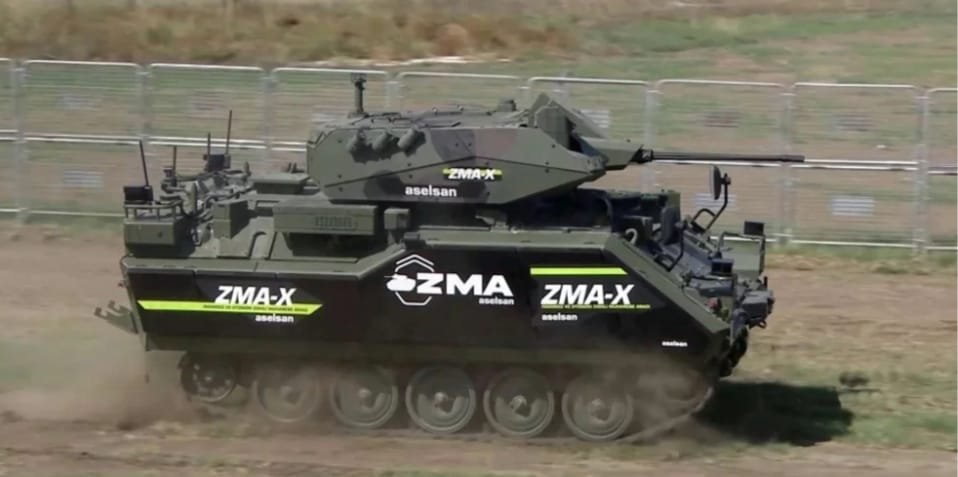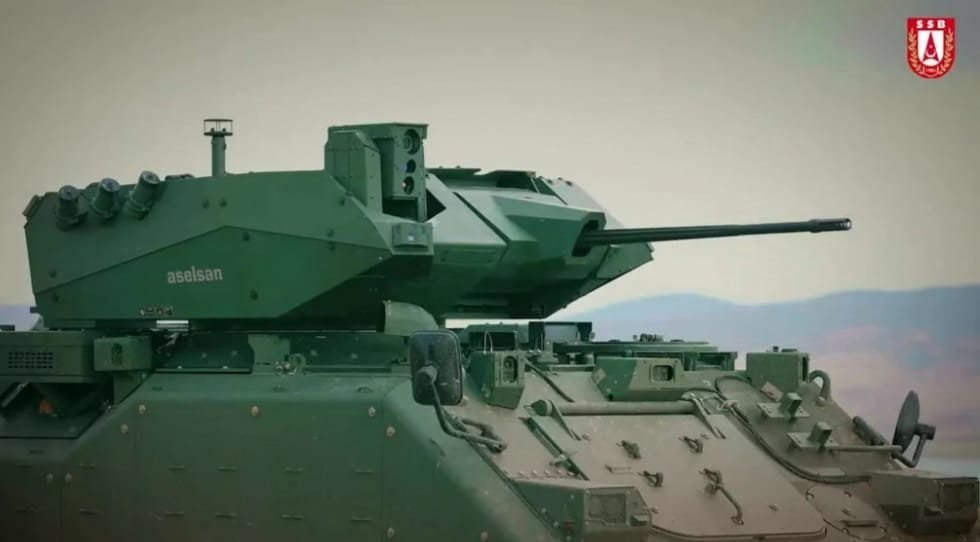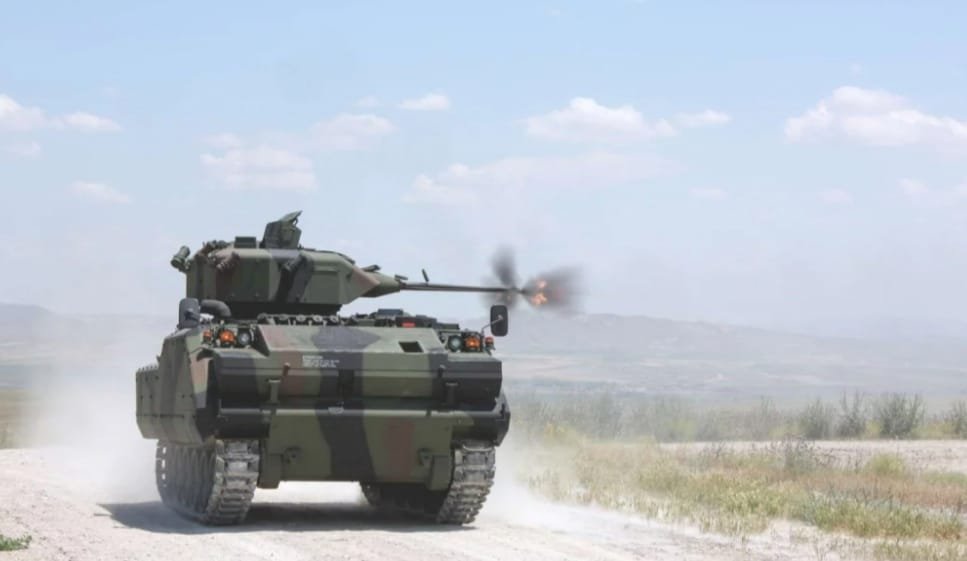
Aselsan’s new ZMA-X UGV enters battlefield with 25 mm chain gun and LIDAR systems
At the Teknofest 2024 exhibition in Türkiye, held between October 2 and October 6, the Turkish company Aselsan introduced the ZMA-X Combat Unmanned Ground Vehicle (UGV), which is based on the modernized ACV-15, also known as the ZMA-15 Infantry Fighting Vehicle (IFV). This vehicle is the third heavy-class UGV developed by the Turkish defense industry, alongside FNSS’ Shadow Rider and Otokar’s Alpar.
As reported by TurDef on October 2, 2024, the ZMA-X is equipped with Aselsan’s Nefer unmanned turret system, featuring a 25 mm chain gun. The remotely controlled turret allows the ACV-15 to be converted into an unmanned platform. Additional armor plates, similar to those on the modernized ACV-15, have been added to improve the vehicle’s protection. The vehicle is also fitted with LIDAR systems, which likely enhance situational awareness, similar to short-range sensors used in FNSS’ Shadow Rider UGV conversion kit for the M113 Armored Fighting Vehicle (AFV).
Several countries have developed unmanned variants of the M113 to enhance battlefield capabilities. The U.S. has tested remotely operated M113s for mine-clearing and fire support under its Robotic Combat Vehicle program in 2024. Australia also tested automated M113s earlier in 2024, focusing on remote-controlled logistics. Israel has deployed unmanned M113 “Zelda” models, equipped with machine guns and capable of carrying 4 tons of payload in urban combat, notably in Gaza. These developments highlight international efforts to modify the M113 for autonomous operations.
The Nefer turret, also known as SARP 100/25, is an unmanned turret designed by Aselsan for tactical vehicles, including 6×6 and 8×8 platforms. It can support both NATO and Russian-origin weapon systems, with the aim of improving situational awareness while reducing personnel exposure to risks. Key features include automatic target tracking, ballistic calculations, and the ability to engage stationary and moving targets while the vehicle is on the move.
The turret is equipped with day and night imaging systems and a gyro-stabilized platform to ensure accuracy. Other features include a laser rangefinder, a fire control system, a round counter, and a last-ammunition warning. Ammunition can be reloaded while protected under armor.
The Nefer turret can support a range of primary and co-axial weapons, including the 30 mm MK44, 30 mm 2A42, 25 mm M242, 25 mm KBA, and 25 mm M811 automatic cannons. Co-axial weapons options include the 12.7 mm M2 and NSV machine guns, and the 7.62 mm FN MAG58/M240 and PKT machine guns. The turret has an elevation range from -10° to +60° and offers 360° azimuth rotation via a slip ring mechanism. It meets military standards for electromagnetic interference (MIL-STD-461E) and environmental conditions (MIL-STD-810F).
Its armor provides protection compliant with STANAG 4569 Level II against small arms fire and shell splinters. The turret weighs less than 1,700 kilograms with a 25 mm cannon, armor, and ammunition. The low profile height of under 70 centimeters allows integration on a variety of vehicles. The ammunition stowage supports up to 200 rounds for 30 mm cannons, 240 rounds for 25 mm cannons, 100 rounds for 12.7 mm machine guns, and 500 rounds for 7.62 mm machine guns.
The ACV-15, which serves as the platform for the ZMA-X UGV, was developed by FNSS and has been in service since 1992. This tracked armored vehicle is used as an infantry fighting vehicle and armored personnel carrier. It is amphibious and based on the American Advanced Infantry Fighting Vehicle (AIFV), a variant of the M113A1. The vehicle is armed with a one-person turret carrying a 25 mm cannon and a 7.62 mm coaxial machine gun, and it can be used for both combat and troop transport.
The development of the ACV-15 was initiated by Türkiye’s Land Forces Command to meet its operational requirements. Türkiye currently operates 2,249 units, the United Arab Emirates has 136, and Malaysia has ordered 267 in various configurations. The vehicle has been deployed in conflicts in Syria, Libya, Somalia, and in operations against the Kurdistan Workers’ Party (PKK).
The ACV-15 is powered by a Detroit Diesel 6V-53T engine producing 300 horsepower, which allows the vehicle to reach a maximum speed of 65 km/h and provides a range of 490 km. Its torsion bar suspension and road wheels enable off-road performance. The vehicle is fully amphibious, relying on track propulsion to cross water obstacles. Standard features include night vision, nuclear, biological, chemical (NBC) protection, and smoke grenade launchers.
In Malaysia, the ACV-15 is referred to as the ACV-300 Adnan, named after Lieutenant Adnan bin Saidi, a World War II hero. This variant is equipped with a 25 mm FNSS Sharpshooter Turret, GPS navigation, laser warning devices, and night vision systems. It was used by Malaysian forces during the 2013 Lahad Datu standoff with Sulu militants.
Several variants of the ACV-15 exist, including logistics support vehicles, mortar carriers, and command vehicles. The heavier ACV-19 variant, also known as the Akıncı ZMA, has an additional road wheel and weighs 18,000 kg, allowing it to carry more personnel and equipment. The ACV-19 can be fitted with a 25 mm Saber turret and anti-tank guided missiles.
The ACV-15 remains in use by several countries, including Türkiye, Malaysia, the UAE, the Philippines, Jordan, and Syria. In some cases, the vehicle has been involved in notable operations. For example, in Idlib, an ACV-15 was reportedly involved in the downing of a Syrian Mi-17 helicopter in cooperation with artillery. In Syria, a captured unit of the vehicle was later recovered by the Syrian Arab Army, showing the vehicle’s presence in ongoing conflicts.


